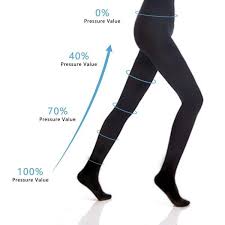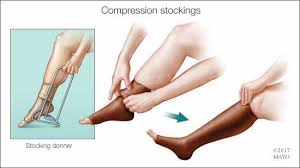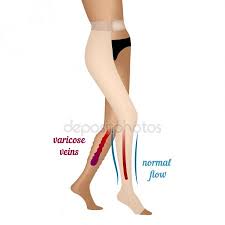If you are suffering from leg swelling or chronic venous insufficiency, aching of the legs or varicose veins your physician may advise use of medical compression tights. These stockings. These socks help in increasing blood flow through pressure applied to the leg.
Compression socks are specialized hosiery which can be worn from the foot to the knee or thigh and in some cases, you can find waist-high tights. They are also available as sleeves which can stretch from the ankle to the knee. These stockings have gradient pressure which is high at the ankle and gradually reduce pressure as you move up your leg. They reduce leg swelling in the feet and also improve venous circulation.
But before you can go purchase compression stockings, you need to first understand what they are, the units of measure of gradient stockings, types and benefits of using compression stockings. If you are a first time user for these socks, then it is important that you get to understand these facts and also comprehend the factors which you need to check out for when choosing a compression stocking.
What are compression tights?
Compression socks are medical grade stockings which have been designed to help in blood circulation. They come in different strength levels depending on your medical condition and its intended use. The various strengths include mild (8-15 mmHg), Medium (15-20 mmHg), Firm (20-30 mmHg) and X-Firm (30-40 mmHg).

There are two numbers in the different compression levels and an mmHg at the end. These are the units of measure for the socks, with the numbers representing the pressure applied. For example the 8-15 mmHg mild strength compression socks, this means that the pressure will not fall below 8 mmHg and will not exceed 15 mmHg. The mmHg represents the unit of measurement – millimeters of mercury – which is a measure of pressure.
This is why you will find the different compression stocking strengths rated with a two number measurement. It means that the socks are graduated with the high pressure applied to the ankle and the low pressure applied to the calves. Graduated compression means that the compression is strongest at the bottom and it gradually reduces pressure as you move up your leg. This allows firm compression allowing blood circulation to improve up and out of the legs. Compression would be detrimental if the pressure was applied in reverse.
These socks strengths are used differently depending on the medical condition or use as stated earlier. Here are the uses of the various compression ranges:
- Light-moderate compression, 15-20 mmHg – these are perfect for travelling. If your work entails standing all day, pregnant or experiencing mild leg swelling, these types of socks will come in handy.
- Moderate compression, 20-30 mmHg – these are great for legs which experience moderate swelling and varicose veins because of pregnancy or another condition. You can also wear them when your legs feel tired and heavy.
- Firm compression, 30-40 mmHg – these are usually required when you have moderate to severe varicose veins, moderate oedema, or after vein treatment such as vein stripping. They also come in handy for combating lymphedema.
- Extra firm compression, 40-50 mmHg – they help with severe oedema, or varicose veins, chronic venous diseases or severe post-thrombotic syndrome.
- Heavy compression, 50-60 mmHg – this is the strongest standard compression level and is primarily used in relieving Post Thrombotic Syndrome and lymphedema.
Types of compression tights
There are three primary types of compression socks. These are:
- Graduated compression socks
- Non-medical support socks
- TED (anti-embolism) socks
Graduated compression hosiery
Graduated compression socks have the compression level strongest at the ankle and the pressure gradually decreases towards the top of the leg. They are designed to meet certain strength and length for mobility and they generally require professional fitting.

Socks which end below the knee helps limit peripheral oedema or leg swelling as a result of fluid buildup. You will find variants which extend to the thigh or waist to reduce pooling of blood in legs thus preventing orthostatic hypotension. Some compression socks suppliers offer personal preferences such as open or closed-toe and color.
Popular Articles on ComproGear
Women’s sex toy called the rose toy rechargeable with USB charging popular on TikTok.
We review the best compression socks for ankle swelling to keep your feet and ankles normal size.
Over 17 samples of compression socks examined to find the best compression socks for nurses who stand all day. Could these compression socks work for non-nurses who also stand all day?
ComproGear has new sizing in 2XL 3XL 4XL 5XL and 6XL wide calf compression socks to fit big legs. The most popular compression sock sizing has been 2XL and 3XL so far.
Got foot and ankle edema? We review the best compression socks for swollen feet, ankles, and calves. Keep your legs looking and feeling great. Stop the edema now!
Non-medical Compression support stockings
This hosiery does not necessarily require a prescription. They include flight socks and elastic support as a potential relief for aching legs. You can purchase these socks online or your local pharmacy.
Anti-embolism tights (TED)
These types of stockings help in reducing the possibility of deep vein thrombosis. Just like the graduated hosiery, they offer gradient compression but the level of compression differs. These types of socks are designed for those who are immobile.
Who can use compression tights?
If you recently had surgery or experiencing leg trauma, your doctor may recommend the use of compression socks during and after a hospital stay. You can also buy this product from a medical supply store or pharmacy.
Medical compression socks are won after DVT diagnosis to reduce some of the discomfort or swelling. Previously the socks were won after acute DVT to decrease the chances of the post-thrombotic syndrome but this is no longer the case.
Medical compression hosiery can be used as a preventative measure. For the best results when using these support stockings, you need to wear the socks the first thing in the morning before you stand. Putting the compression socks after standing and moving around can cause swelling and at which point it can become harder to put on the socks. Bear in mind that you will need to remove the socks before taking a shower.

Since medical support stockings are tight and elastic, applying lotion to your skin before wearing them will help the material glide up your leg. But make sure that the lotion is well absorbed into the skin before putting on the socks.
Putting on compression stockings will require grabbing the top of the socks, rolling it down toward the heel, putting your foot inside the socks and slowly unrolling the socks up your leg.
When using medical support tights, it is recommended that you wear medical stockings continuously throughout the day and remove them when going to sleep. You can take care of the socks by washing the socks with mild soap and air drying them. Because you will be using the compression socks daily, you can purchase 2 pairs so that when one is washed, you can use the second pair. You should also replace your compression stockings every four to six months.
How to put on support stockings
Wearing compression hosiery takes a little practice. The best way to wear them is to grab the toe and fold the rest of the socks inside out. Continue by placing your foot into the toe area and roll the rest of the socks over your ankle and calf.
It is recommended that you put on the support stockings in the morning after waking up as this is the time before your leg develops swelling. It is impossible to put on compression socks in the confines of a plane.
Remember that if you feel discomfort while wearing the compression socks, then you have the wrong compression level. This can cause more harm than good. Wearing compression stocking should feel like your calves are receiving a gentle hug from the socks.
Choosing support stockings
As earlier mentioned, there are a variety of support stockings sold in the market. These socks differ in compression strength, material, style, length and size. We understand that it can be overwhelming when selecting your compression hosiery, but below are some of the factors which can guide you when purchasing your first compression stocking. However, if you are choosing compression socks due to a medical condition, then it is best that you first seek medical advice from your doctor.
Popular Articles on ComproGear
Dealing with edema (swelling) in your feet and ankles? We review the best ankle swelling compression socks to stop foot and ankle swelling. Compression socks can stop the edema instantly.
What level of compression socks do I need? Compression socks levels (10-20 mmHg, 20-30mmHg, etc…) explained. Includes mmHg chart.
Super plus size compression stockings: bariatric compression socks now available in 3XL, 4XL, 5XL, and 6XL to fit all leg sizes.
Compression sock pressure levels explained: What does 20-30 mmHg mean in compression socks? Includes compression socks pressure chart.
No doctor’s prescription needed. How to buy compression socks online with minimal effort, free returns, and a lifetime guarantee.
Compression level
The compression level is the first aspect you will need to check before buying a compression sock. as stated above, the standard compression strengths include:
- Mild (8-15 mmHg)
- Medium (15-20 mmHg)
- Firm (20-30 mmHg)
- X-Firm (30-40 mmHg)
The mild and medium compression levels can be purchased from your local pharmacy or online shop but the stronger strengths will need a doctors prescription. The stronger strengths are used to treat and remedy serious medical conditions and using them may bring more harm than good.

Material
The material used to make the medical tights will depend on the need for the compression stockings. Some are made of rubber, Lycra or spandex and they come in different lengths like knee, thigh or full. If your need for compression socks is because you are flying for a long period, then you need to choose a sock that is comfortable for you.
Size
You need to find the correct size when choosing your socks. Retailers will provide a measurement chart which will instruct you on how to best determine your size. These charts depend on what type of compression hosiery you desire. For example, your shoe size will greatly influence a knee sock or over the knee sock. Full compression socks are usually sized regular in department stores. The size of your stocking is based off a ratio between weight and height. Other may require measurements for ankle circumference, calf-length and calf circumference.
Style
You should also choose a style which will fit perfectly with your attire. Retailers will give you an option from which you can choose from. You can choose from plain colors to a blend of colors, all depending on your need. You can also choose between closed or open-toe compression socks.
Benefits of support tights
Compression socks offer a variety of benefits to users. It provides pressure to the ankles and calves thus reducing swelling and aching of the legs. The pressure applied helps improve blood flow in your legs back to your heart. Below are some of the benefits offered by compression tights.
Speedy Injury recovery
Doctors recommend using compression socks to naturally stimulate the healing of the body. Compression stockings are helpful after a patient has undergone surgery and when managing chronic illnesses and pain. But be sure to consult your healthcare provider as compression socks are not recommended for some medical conditions.

Maternity relief
Pregnant women will find immediate relief from aching and swollen feet when they use compression hosiery. The compression stockings and sleeves offer a comfortable, cooling effect and are easy to put on.
Comfort
Lack of mobility when travelling or working may cause low blood flow and puts you at risk of dangerous blood clots. This is highly reduced when using support stockings.
Athletic performance
Wearing compression socks during and post workouts will improve muscle recovery. Wearing the stockings will naturally alleviate lactic acid from building up and reduce wear and tear on the muscle.
Conclusion
Medical compression stockings have many uses and help alleviate different conditions and also bring comfort for hardworking nurses and long haul travelers. Using the right compression strength will bring these benefits but the wrong compression level can be detrimental to your health. Support stockings are used to ensure that there is improved blood circulation to your feet. By following the above guide, you are sure to receive the aforementioned benefits.
This page last updated November 5, 2022
